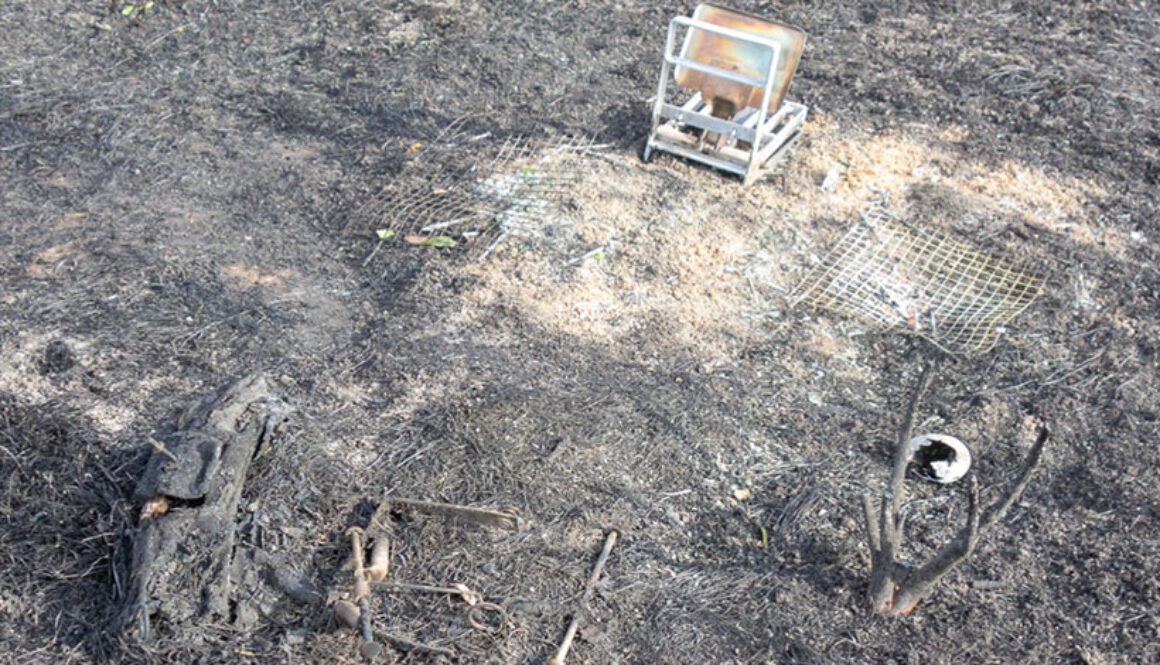Fire and trapping update
Top image: remains of a DOC200 trap in the background and a Timms in the foreground.
River Traps
Early in February, there were two fires on the northern berm of the Ashley. The upstream one has incinerated 2 traps on Line M, all 13 traps on Line D, 10 of 13 on Line C and 7 of 20 on Line B. In addition, about 7 bait stations were burnt. The downstream fire was in the area of Line L and it is suspected that several the 15 traps here will also have been destroyed. When firefighting and clean-up efforts have been completed, we can assess where to put new traps – these will have to be purchased and boxes made for the DOC mechanisms. As of the evening of 6 February, the fires were still being fought and the area may still be subject to a crime scene investigation.
The drop in catch between November and December 2019 proved to be a false dawn – with a large increase this month – total of 87 predators in January vs 40 in December. Trap numbers in these months were similar. Last month it was speculated that perhaps bait stations were influencing ship rat and weasel numbers, this now seems to have been premature– with big increases in catch for both species.
Norway rat numbers have remained about the same, but hedgehog numbers have gone from 14 to 37. Now that the river has dried up for a large part of its course, hedgehogs are being caught on what used to be islands in the middle of the fairway. Three were caught on Line 192 after the river had dried out. These traps are around the large “Railway” gull and tern colony downstream of the railway bridge. The traps from the Toppings gull colony (Line 193 – where only 1 Norway rat was caught, after the birds had left) were shifted to a permanently vegetated island (now with dry channels around it) downstream from the Railway colony. Here they immediately caught 2 hedgehogs.
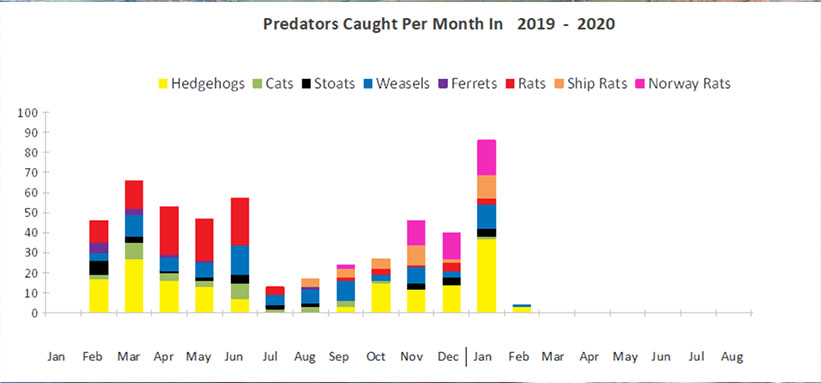
After the black-billed gull fledglings left the Railway colony it was possible to gauge the full extent of damage done by land predators. Despite our installation of temporary traps around this colony, it appears that about 110 gull chicks (from about 900 nests) were killed and eaten by ground predators – around 100 of these are suspected to be by Norway rats. Our traps at probable den/nest sites in willow near the edge of the water were quite successful in catching rats, but it appears that other rats walked right past our traps which were closer to the colony. Nothing was caught in these traps – along a line of lupins. Fresh gull chick was obviously much more appetising than cat biscuits and peanut butter in a run-through trap.
The rats have eaten their prey very close to where it was caught – within the colony perimeter. In places there are piles of remnant carcasses. They leave bones and wings, gnawing away the meat and sometimes just making a hole in the bird’s abdomen.
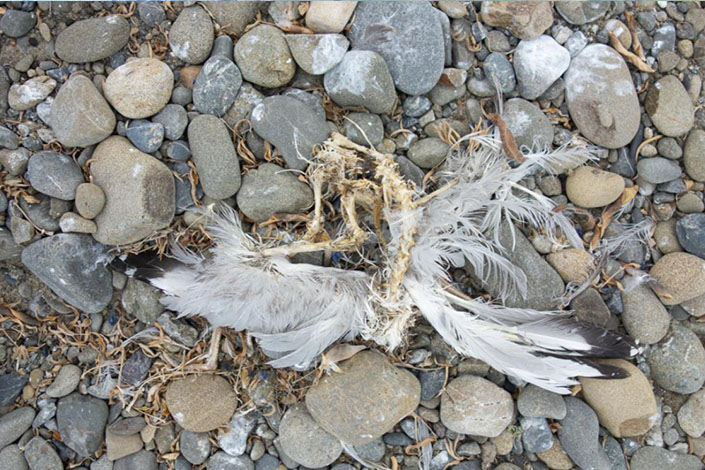
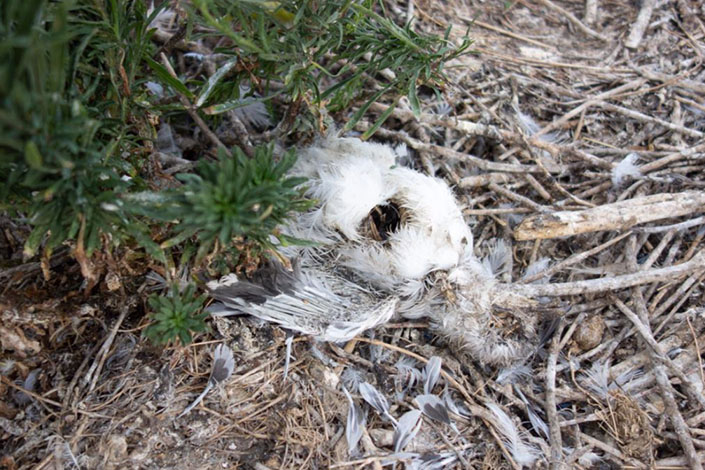

Only one other predator was caught on the Railway colony island whilst the birds were in residence. This was a stoat – it appears to have carried several young birds about 250m away from the colony and eaten them under willow. Much less was left of these birds – only parts of wings.
More evidence is of course needed as to the nature of the predators. We only caught Norway rats and 1 stoat during the period the birds were there, but it is possible that other predators were active. Next season we should have more trail cameras available. We have had 2 on the island this year, one got stolen and the other is still in place.
Next season bait stations will probably have to be used close to colonies and weeds close to the colony areas will need to be pulled.
Harriers were even more prolific killers than the rats – about 117 gull chick remnants can be attributed to them. They catch young gulls either from the ground or in the air and take them to the riverbanks to eat. At the end of December only about 20 gulls appeared to have been killed by harriers. This dramatically increased once the young gulls left the colony area and had fewer adults to protect them. Last year harriers were almost always entirely eating their prey – leaving just piles of feathers. This year many young gulls were only partly eaten. It appears that one or more harriers were catching more than they could eat. Harriers are rather like black-backed gulls in that their numbers are unnaturally high. Next year we might have to consider using scarecrows to protect nesting colonies.
The remains of 91 chicks that probably died naturally were found within the Railway colony area. At this colony it wasn’t possible to get a count of birds that successfully fledged.
At the Toppings colony no predators were caught during the time the gulls were in residence and no evidence of ground predation was found. Harriers here appear to have killed and eaten only 3 gull chicks.
The damage that harriers may have done to tern eggs and chicks is not known. But Norway rats are strongly suspected of wiping out many nests and perhaps killing chicks.
The graph below shows that Lines 192, F and M caught the most predators in January.

We report catch per hundred trap night figures at six-month intervals – from February to July and from August to January (approximately the nesting season). This figure, from 1 August 2019 to 31 January 2020 was 0.48. This is quite similar to that from recent seasons.
Estuary Traps
Catch continued to increase with a total of 26 compared to 22 in December. There were a few more predators caught in January 2019 than in January 2018 but there were two extra lines – I and J were put in during late January 2019.

Rats were yet again the main catch – with Ship rats outnumbering Norway rats. The number of hedgehogs caught in January (4) was the largest for a month since we started trapping. In
the last two months we have caught 6 hedgehogs compared with a total of 9 in the preceding 17 months. The area has had an unusually low hedgehog catch compared with further up the river and the Tuhaitara area, hopefully this isn’t the start of a hedgehog comeback. Stoats still make up a greater proportion of the catch than is the case further up the river.
This season pied stilts, banded dotterels and black-fronted terns nested on a large gravel area just above where the river enters the estuary – this is between lines C and D. There were also banded dotterel nests further up the river close to SH1 and at least one black-fronted dotterel also nested along here. No attempt was made to follow the success of this nesting or to try to ascertain whether land or airborne predators were active. The biggest threat to the birds was probably human disturbance, especially during the whitebait season when there were a lot of people, vehicles and dogs along this section of the river. Black-backed gulls could also be a major problem. Some dotterels seem to have successfully nested along the beach and other species such as oyster-catchers were nesting elsewhere. Perhaps the estuary trapping group could do some nest monitoring next season. Failure of dotterel nesting at Kaikoura has been a major issue, it would be useful if we could find out what the situation is in our area.
Fledgling wrybills, black-billed gulls and black-fronted terns tend to congregate in the estuary after leaving the river. These would probably also be threatened by predators. This year several young terns and black-billed gulls were there. On 28 January about 125 black-billed gull fledglings, with some adults, were seen between the eastern ends of Line C and Line B. These were almost certainly from the Toppings colony.
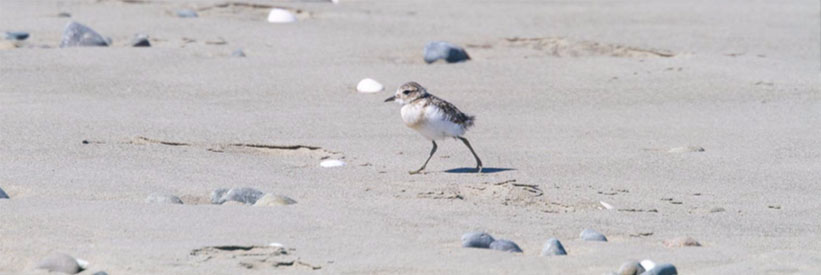
Lines D, F and G had the largest catch in January.
For the 6 month period between 1 August 2019 and 31 January 2020 the catch per 100 trap nights was 0.36.
Grant Davey, 6/2/20


